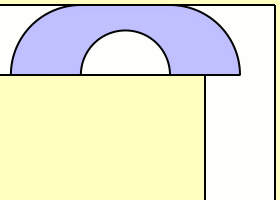Once you remember you can die because of sonic hedgehog genes, you know scientists are the same jokers with degrees.
my favorite is the Cox-Zucker Machine
conceived of the idea of coauthoring a paper for the express purpose of enabling this joke. They followed through on it five years later
The sheer determination and commitment for telling a dick joke. And here I am not being able to tell you if I’ll be employed a year later.
I also love the way Cox put it:
A few weeks after we met, we realized that we had to write a joint paper because the combination of our last names, in the usual alphabetical order, is remarkably obscene.
That is such a lovely nerd way to put “We found the combo of our last names hilarious”
Thank god this image has a grand total of 20 pixels.
Ambidextrous Sofa

In mathematics, the moving sofa problem or sofa problem is a two-dimensional idealization of real-life furniture-moving problems and asks for the rigid two-dimensional shape of the largest area that can be maneuvered through an L-shaped planar region with legs of unit width.
A variant of the sofa problem asks the shape of the largest area that can go around both left and right 90-degree corners in a corridor of unit width (where the left and right corners are spaced sufficiently far apart that one is fully negotiated before the other is encountered).
Cantor’s Leaky Tent
In topology, a branch of mathematics, the Knaster–Kuratowski fan […] is a specific connected topological space with the property that the removal of a single point makes it totally disconnected. It is also known as Cantor’s leaky tent […].
Sexy Prime
In number theory, sexy primes are prime numbers that differ from each other by 6.
In mathematics, the coin problem […] is a mathematical problem that asks for the largest monetary amount that cannot be obtained using only coins of specified denominations. For example, the largest amount that cannot be obtained using only coins of 3 and 5 units is 7 units.
[…]
One special case of the coin problem is sometimes also referred to as the McNugget numbers. […] A McNugget number is the total number of McDonald’s Chicken McNuggets in any number of boxes. In the United Kingdom, the original boxes (prior to the introduction of the Happy Meal–sized nugget boxes) were of 6, 9, and 20 nuggets.
According to Schur’s theorem, since 6, 9, and 20 are (setwise) relatively prime, any sufficiently large integer can be expressed as a (non-negative, integer) linear combination of these three. Therefore, there exists a largest non–McNugget number, and all integers larger than it are McNugget numbers.
Ugly Duckling Theorem
The ugly duckling theorem is an argument showing that classification is not really possible without some sort of bias. More particularly, it assumes finitely many properties combinable by logical connectives, and finitely many objects; it asserts that any two different objects share the same number of (extensional) properties. The theorem is named after Hans Christian Andersen’s 1843 story “The Ugly Duckling”, because it shows that a duckling is just as similar to a swan as two swans are to each other.
Can’t forget the Hairy ball theorem
The link is broken.
Thanks, fixed it
Is the sexy prime thing because six is sorta similar to sex? Are the mathematicians also doing puns? First they make word problems, now this. Stay in your fucking lane.
Literally everything is mathematics or an application thereof, their lane is the entire fucking road.
Ham sandwich theorem!
Don’t forget the bunkbed conjecture
Hairy ball theorem
“Shit.”
“What?”
“Mathematicians.”
“Shit.”
“Yeah.”
*sounds of weapons being checked, loaded*
What? No, we love mathematicians.
Fuck Macdonald’s though
TBH, my math professor called it Sylvester’s theorem. I didn’t see “Chicken McNugget theorem” name until I searched for it on the internet in English.







